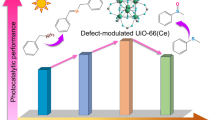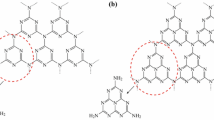Abstract
A photoactive difluoroborate-based conjugated organic polymer (B-COP) with A3B2-type donor–acceptor arrays in the polymer framework was synthesized by direct polycondensation and exhibited amorphous structure, high thermal and photophysical stability. The B-COP was shown to be a highly efficient heterogeneous photocatalyst for a wide range of photocatalytic transformations, including the oxidative coupling of primary amine and cross-dehydrogenative coupling reactions between tetrahydroisoquinolines and nucleophiles such as nitromethane, nitroethane, acetone and phenylethyl ketone.


Similar content being viewed by others
References
Sun CL, Li BJ, Shi ZJ (2011) Direct C–H transformation via iron catalysis. Chem Rev 111:1293–1314
Godula K, Sames D (2006) C–H bond functionalization in complex organic synthesis. Science 312:67–72
Bergman RG (2007) Organometallic chemistry: C–H activation. Nature 446:391–393
Li CJ (2009) Cross-dehydrogenative coupling (CDC): exploring C–C bond formations beyond functional group transformations. Acc Chem Res 42:335–344
Li Z, Li CJ (2005) Highly efficient copper-catalyzed nitro-mannich type reaction: cross-dehydrogenative-coupling between sp3 C–H bond and sp3 C–H bond. J Am Chem Soc 127:3672–3673
Condie AG, González-Gómez JC, Stephenson CRJ (2010) Visible-light photoredox catalysis: aza-henry reactions via C–H functionalization. J Am Chem Soc 132:1464–1465
Wu CJ, Zhong JJ, Meng QY, Lei T, Gao XW, Tung CH, Wu LZ (2015) Cobalt-catalyzed cross-dehydrogenative coupling reaction in water by visible light. Org Lett 17:884–887
Wang B, Shelar DP, Han XZ, Li TT, Guan X, Lu W, Liu K, Chen Y, Fu WF, Che CM (2015) Long-lived excited states of zwitterionic copper(I) complexes for photoinduced cross-dehydrogenative coupling reactions. Chem Eur J 21:1184–1190
Zhong J, Meng Q, Wang G, Liu Q, Chen B, Feng K, Tung C, Wu L (2013) A highly efficient and selective aerobic cross-dehydrogenative-coupling reaction photocatalyzed by a platinum(II) terpyridyl complex. Chem Eur J 19:6443–6450
Neumann M, Zeitler K (2012) Application of microflow conditions to visible light photoredox catalysis. Org Lett 14:2658–2661
Tucker JW, Zhang Y, Jamison TF, Stephenson CRJ (2012) Visible-light photoredox catalysis in flow. Angew Chem Int Ed 51:4144–4147
Gandy MN, Raston CL, Stubbs KA (2015) Photoredox catalysis under shear using thin film vortex microfluidics. Chem Commun 51:11041–11044
Möhlmann L, Baar M, Rieß J, Antonietti M, Wang X, Blechert S (2012) Carbon nitride-catalyzed photoredox C–C bond formation with N-aryltetrahydroisoquinolines. Adv Synth Catal 354:1909–1913
Mitkina T, Stanglmair C, Setzer W, Gruber M, Kisch H, König B (2012) Visible light mediated homo- and heterocoupling of benzyl alcohols and benzyl amines on polycrystalline cadmium sulfide. Org Biomol Chem 10:3556–3561
Rueping M, Zoller J, Fabry DC, Poscharny K, Koenigs RM, Weirich TE, Mayer J (2012) Light-mediated heterogeneous cross dehydrogenative coupling reactions: metal oxides as efficient, recyclable, photoredox catalysts in C–C bond forming reactions. Chem Eur J 18:3478–3481
Wang C, Xie Z, DeKrafft KE, Lin W (2011) Doping metal-organic frameworks for water oxidation, carbon dioxide reduction, and organic photocatalysis. J Am Chem Soc 133:13445–13454
Xie Z, Wang C, DeKrafft KE, Lin W (2011) Highly stable and porous cross-linked polymers for efficient photocatalysis. J Am Chem Soc 133:2056–2059
Windle CD, Perutz RN (2012) Advances in molecular photocatalytic and electrocatalytic CO2 reduction. Coord Chem Rev 256:2562–2570
Liu W, Su Q, Ju P, Guo B, Zhou H, Li G, Wu Q (2017) A hydrazone-based covalent organic framework as an efficient and reusable photocatalyst for the cross-dehydrogenative coupling reaction of N-aryltetrahydroisoquinolines. Chemsuschem 10:664–669
Ding S, Wang W (2013) Covalent organic frameworks (COFs): from design to applications. Chem Soc Rev 42:548–568
Gu C, Huang N, Wu Y, Xu H, Jiang DL (2015) Design of highly photofunctional porous polymer films with controlled thickness and prominent microporosity. Angew Chem Int Ed 54:11540–11544
Li D, Zhang H, Wang Y (2013) Four-coordinate organoboron compounds for organic light-emitting diodes (OLEDs). Chem Soc Rev 42:8416–8433
Xu HS, Ding SY, An WK, Wu H, Wang W (2016) Constructing crystalline covalent organic frameworks from chiral building blocks. J Am Chem Soc 138:11489–11492
Zhai L, Liu M, Xue P, Sun J, Gong P, Zhang Z, Sun J, Lu R (2016) Nanofibers generated from nonclassical organogelators based on difluoroboron β-diketonate complexes to detect aliphatic primary amine vapors. J Mater Chem C 4:7939–7947
Zhuang X, Zhao W, Zhang F, Cao Y, Liu F, Bi S, Feng X (2016) A two-dimensional conjugated polymer framework with fully sp2-bonded carbon skeleton. Polym Chem 7:4176–4181
Ding X, Guo J, Feng X, Honsho Y, Guo J, Seki S, Maitarad P, Saeki A, Nagase S, Jiang D (2011) Synthesis of metallophthalocyanine covalent organic frameworks that exhibit high carrier mobility and photoconductivity. Angew Chem Int Ed 50:1289–1293
Bartling H, Eisenhofer A, König B, Gschwind RM (2016) The photocatalyzed Aza-Henry reaction of N-aryltetrahydroisoquinolines: comprehensive mechanism, H•- versus H+- abstraction and background reactions. J Am Chem Soc 138:11860–11871
Liras M, Pintado-Sierra M, Iglesias M, Sánchez F (2016) A deprotection strategy of a BODIPY conjugated porous polymer to obtain a heterogeneous (dipyrrin)(bipyridine)ruthenium(II) visible light photocatalyst. J Mater Chem A 4:17274–17278
Rueping M, Vila C, Koenigs RM, Poscharny K, Fabry DC (2011) Dual catalysis: combining photoredox and Lewis base catalysis for direct Mannich reactions. Chem Commun 47:2360–2362
Liu Q, Li YN, Zhang HH, Chen B, Tung CH, Wu LZ (2012) Beactivity and mechanistic insight into visible-light-induced aerobic cross-dehydrogenative coupling reaction by organophotocatalysts. Chem Eur J 18:620–627
Tibbetts JD, Carbery DR, Emanuelsson EAC (2017) An in-depth study of the use of Eosin Y for the solar photocatalytic oxidative coupling of benzylic amines. ACS Sustainable Chem Eng 5:9826–9835
Acknowledgements
This work was supported by the National Natural Science Foundation of China (No. 51703076) and the Excellent Young Teachers Program of Jilin University. Q.S. thanks the open projects in State Key Lab of Inorganic Synthesis and Preparative Chemistry, Jilin University.
Author information
Authors and Affiliations
Corresponding authors
Ethics declarations
Conflicts of interest
All the authors declare that they have no conflicts of interest.
Electronic supplementary material
Below is the link to the electronic supplementary material.
Rights and permissions
About this article
Cite this article
Liu, W., Wu, S., Su, Q. et al. Difluoroborate-based conjugated organic polymer: a high-performance heterogeneous photocatalyst for oxidative coupling reactions. J Mater Sci 54, 1205–1212 (2019). https://doi.org/10.1007/s10853-018-2893-0
Received:
Accepted:
Published:
Issue Date:
DOI: https://doi.org/10.1007/s10853-018-2893-0




